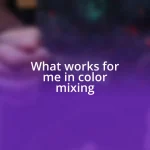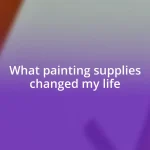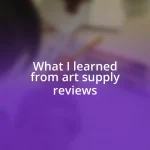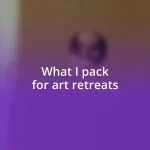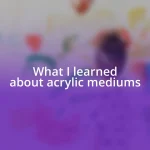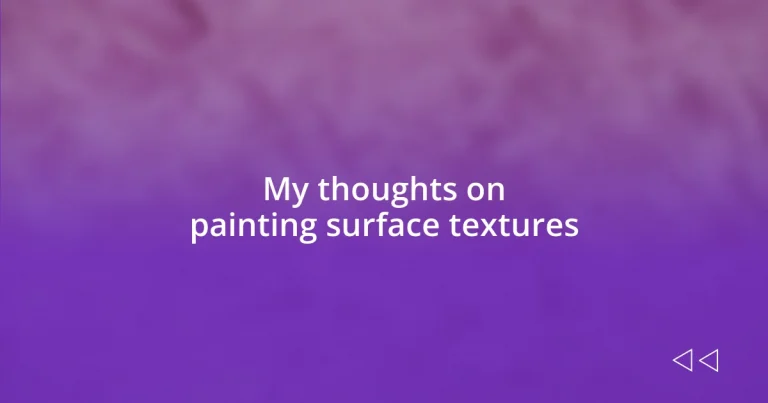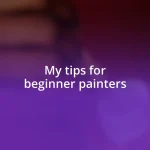Key takeaways:
- The choice of painting surface significantly impacts the texture, colors, and emotional depth of the artwork, influencing the artist’s technique and creative expression.
- Exploring various surfaces, such as canvas, wood, and unconventional materials, can lead to unique artistic discoveries and enhance the overall painting experience.
- Experimenting with different tools and techniques, such as layering and using everyday items, fosters creativity and invites unexpected outcomes in the texture and depth of paintings.
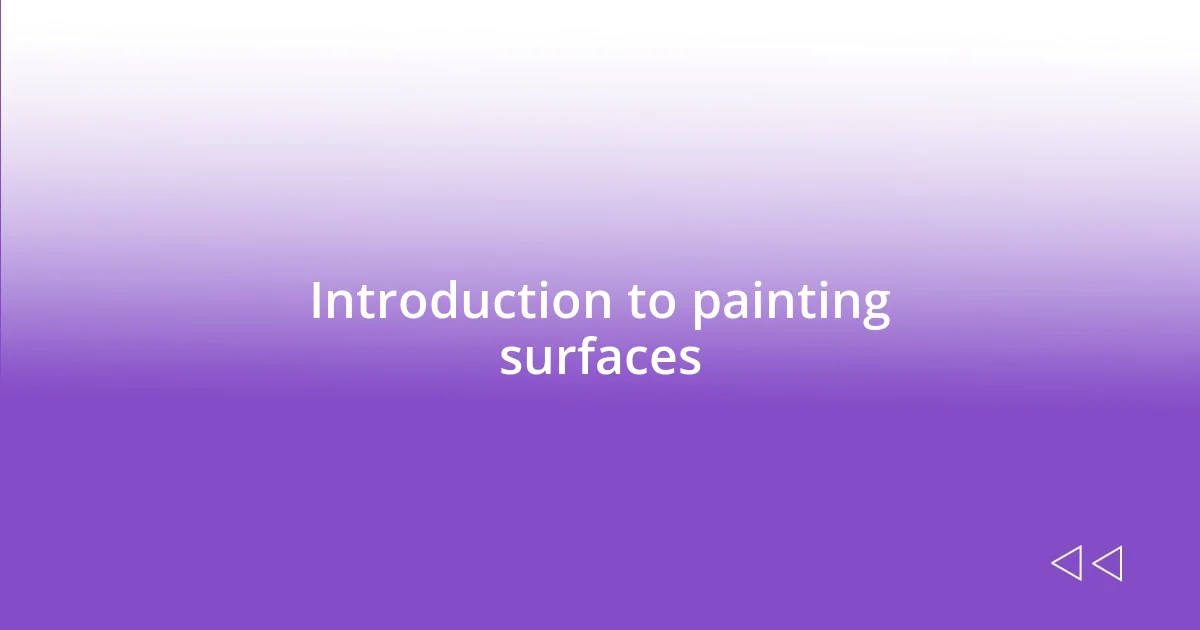
Introduction to painting surfaces
When I first started painting, I underestimated the importance of surfaces. Pondering my initial attempts, I wouldn’t have guessed how much the texture could affect the final outcome. Have you ever realized how a rough canvas can create a completely different feeling than a smooth one?
Every surface tells its own story, inviting us to explore various techniques and materials. I often find myself tracing my fingers over the textures, feeling the potential waiting to be unleashed. The way light interacts with different surfaces can transform a simple stroke into something remarkable, don’t you think?
Choosing the right painting surface involves more than just practicality; it’s about connecting with the medium. I remember being captivated by the vibrant hues that sprang to life on a well-prepared wood panel. It’s these little details that can evoke emotions and inspire creativity, ultimately shaping the painting journey in unique ways.
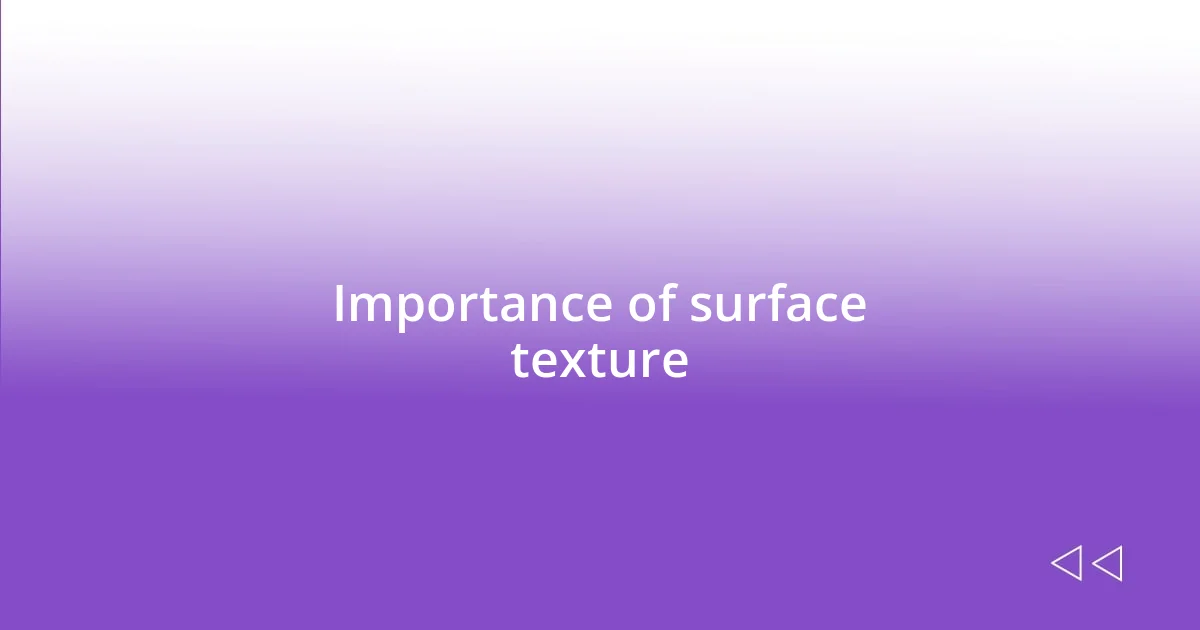
Importance of surface texture
Understanding the importance of surface texture in painting can truly elevate your artistry. I remember experimenting with different canvases and discovering how a rough surface could enhance the intensity of colors. It’s fascinating how texture can act like a magnifying glass, amplifying emotions and depth in a piece. Have you ever noticed how certain textures evoke memories or feelings? It’s almost as if they have a language of their own.
In my experience, surface texture significantly influences the painting technique I choose. For instance, when working on a slick, smooth surface, I found myself leaning towards delicate brushwork, while a coarse canvas called for more vigorous strokes. This relationship between the surface and technique creates a unique dialogue in every artwork. Have you considered how your choice of texture might reflect your creative voice?
The connection between the artist and the surface is more than technical; it’s deeply personal. I vividly recall a painting I created on a weathered piece of cardboard. That imperfect surface carried imperfections that strangely resonated with my own journey. Each wrinkle and ripple told a story, making the final piece a true reflection of my emotions at that moment. It’s these textures, filled with character, that often lead to the most profound creations.
| Surface Texture | Impact on Art |
|---|---|
| Rough | Enhances color vibrancy and adds depth |
| Smooth | Encourages delicate detailing and fine brushwork |
| Textured (e.g., canvas) | Creates dynamic visual interest and emotional resonance |
| Impacted base (e.g., cardboard) | Conveys personal stories and imperfections |
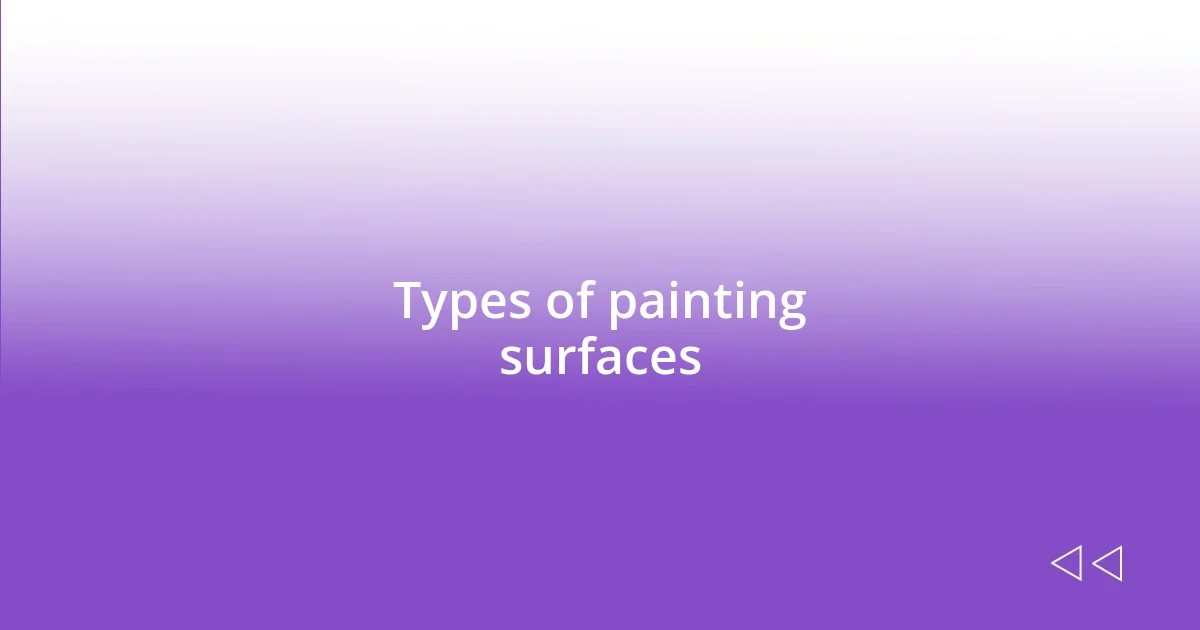
Types of painting surfaces
When it comes to painting surfaces, the choices can truly be overwhelming. I once stumbled upon an old wooden board while rummaging through my garage, and decided to experiment with it. Each groove and knot in the wood seemed to speak, allowing my paint to sit differently than it did on a typical canvas. I painted a landscape that felt grounded and earthy, almost as if the surface infused the work with life. Here are some common types of painting surfaces that I often consider:
- Canvas: A classic choice that comes in various textures.
- Wood Panels: These provide a solid, sturdy foundation with a unique texture.
- Paper: Lighter and more versatile; different papers can produce varied effects.
- Canvas Board: This offers a rigid alternative to traditional canvas.
- Cardboard: An unconventional pick that embraces imperfection and can tell a personal story.
Exploring these surfaces can lead to exciting discoveries. One time, I used a piece of textured paper I had saved from a packaging box. It was unexpectedly delightful— the paint danced across the surface differently than on a smoother canvas, encouraging me to experiment with more spontaneous brushwork. Each surface, as I’ve learned, has its quirks that can help or hinder the creative flow. It’s almost like they have personalities of their own, don’t you agree?
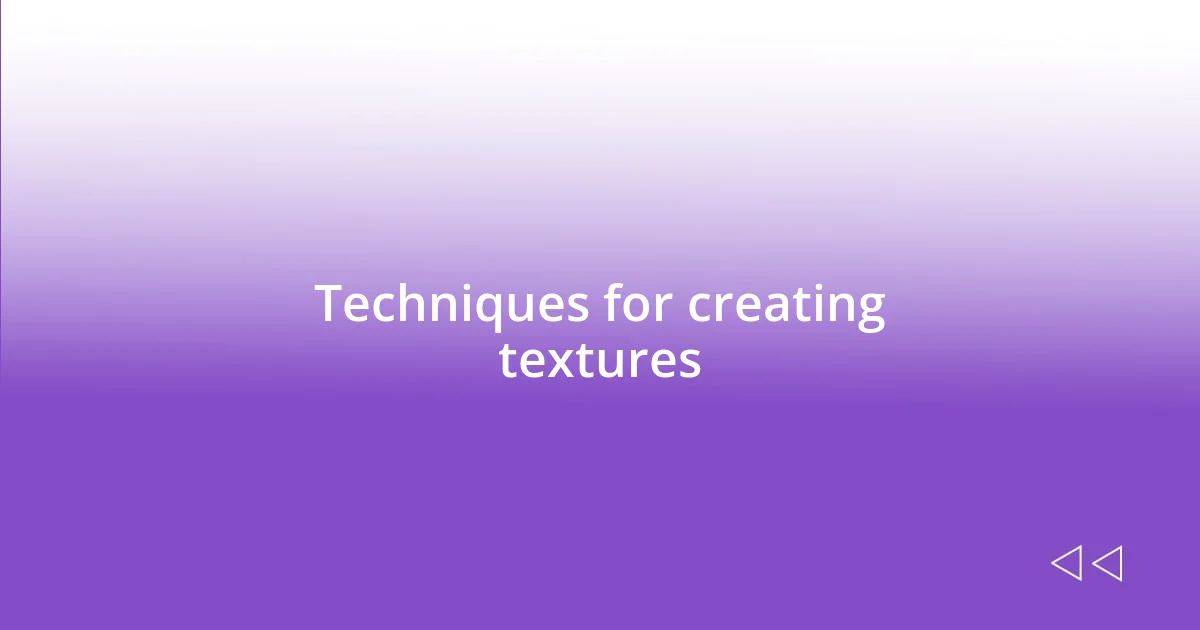
Techniques for creating textures
Creating texture in painting is all about the techniques you employ. One of my favorite methods is using a palette knife. I still remember the first time I mixed vibrant colors directly on the canvas with one. The way the paint layers piled up created a stunning, almost three-dimensional effect that made the piece pop. Have you ever experienced that revelation in texture while painting? It’s not just about the colors—it’s how they interact with the surface that truly captivates.
Another technique that I’ve found incredibly rewarding is incorporating mixed media. By introducing materials like sand or fabric into my paints, I’ve been able to achieve unexpected effects. I once used coarse sand to texture a beach scene, and it not only added depth but also brought the tactile feeling of sand into the artwork. I often find myself pondering: how can something simple transform a flat surface into a multisensory experience?
Layering is another exciting approach. I like to apply multiple thin layers of paint, allowing each to dry before adding the next. This can create a subtle richness to the texture that feels almost alive. I vividly recall working on a series of abstract pieces where the interplay of light and shadow through the layered paint gave depth and interest. Have you tried layering in your own work? It’s a thrilling journey as you watch each layer unveil new possibilities.
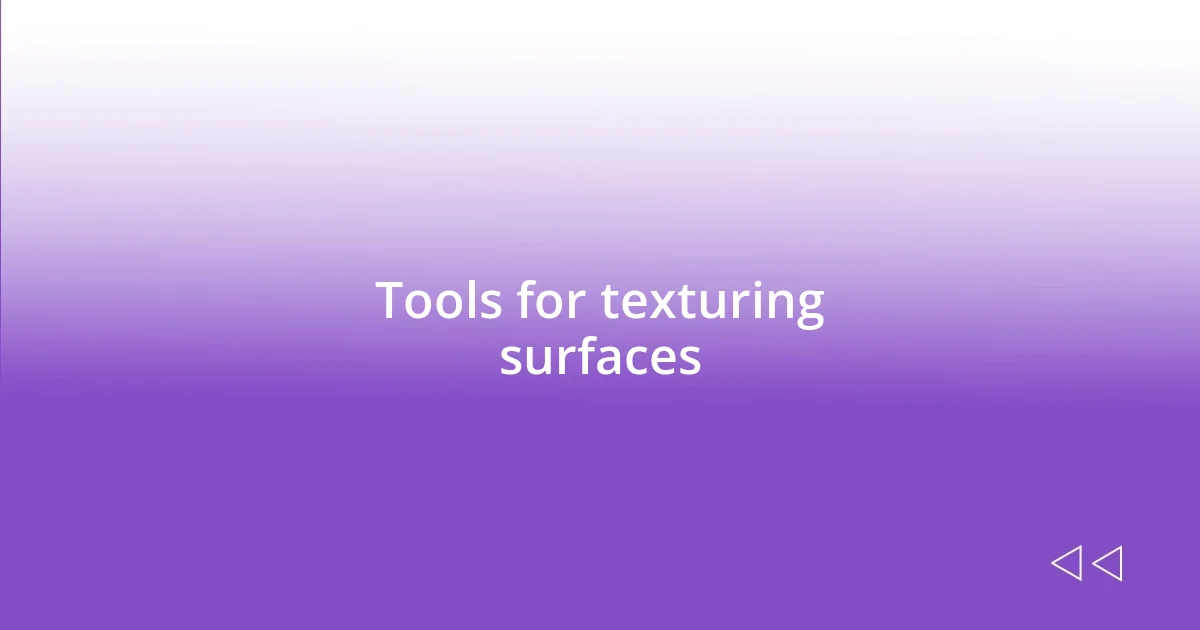
Tools for texturing surfaces
When it comes to tools for texturing surfaces, my go-to has always been the humble brush. I remember my first experience using a stiff-bristled brush; the rough fibers dragged the paint across the canvas in a way that created delightful ridges and valleys. Have you ever felt the rush when experimenting with different brushes? It’s fascinating how something so simple can yield such complex results.
Another surprising tool that I’ve incorporated is a credit card. You’d be amazed at what you can achieve with those! I once used a plastic card to scrape paint across a surface, allowing for a unique transfer of color that felt both spontaneous and deliberate. Isn’t it liberating to know that everyday items can transform your artistic expression? It completely reshaped how I approach a canvas, inviting a sense of playful experimentation.
Lastly, let’s not overlook the sponge; it’s one of those tools that often gets underrated. I fondly recall blending soft colors using a sponge, dabbing it gently to create a cloud-like texture. The tactile experience of the paint against the sponge added an unexpected layer of enjoyment to the process. Have you ever tried sponging to create depth? It’s those kinds of moments that elevate your artwork and keep the creative energy flowing.
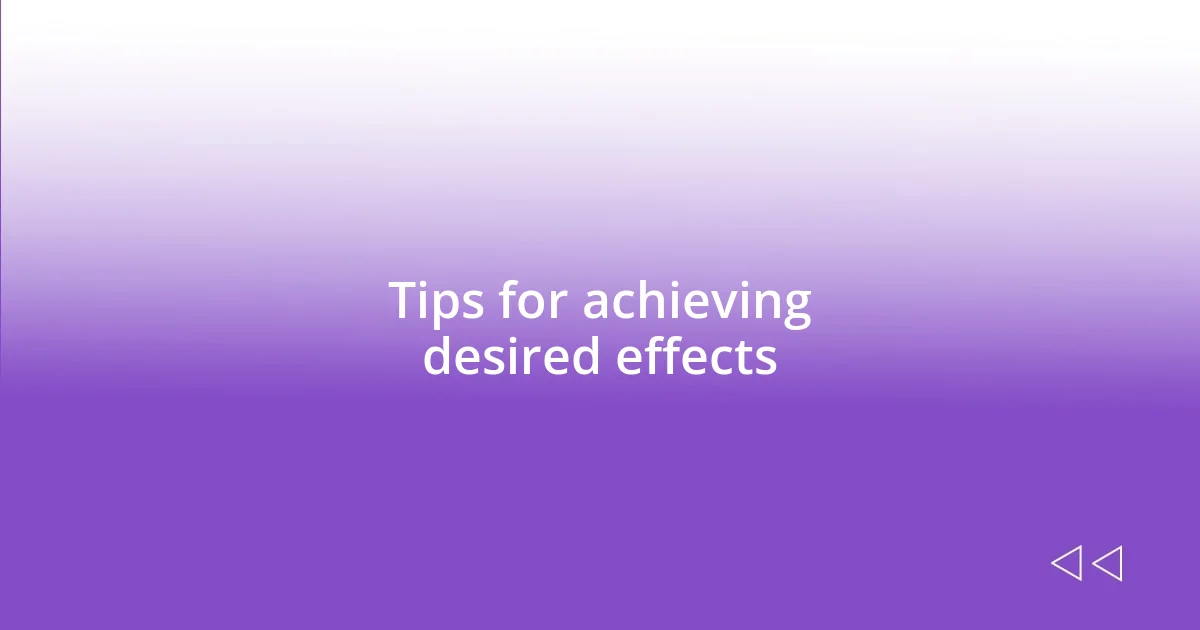
Tips for achieving desired effects
To achieve the desired effects, don’t underestimate the power of experimentation. I remember my first few attempts at utilizing unconventional tools like crumpled paper towels—I was skeptical at first. But when I pressed them into wet paint, the unique texture that emerged was both surprising and delightful. It made me think: what other ordinary objects could take my art to new heights?
Another tip I have is to play with the angles of your brushstrokes. I once discovered that tilting my brush at different angles revealed an entirely new texture that made my painting come alive. Watching the paint interact with the canvas from that perspective gave me a refreshing sense of control. Have you ever noticed how just a slight shift can change the entire feel of a piece?
Lastly, always be mindful of the drying times between your layers. In one project, I layered a thick paint over a thinly dried base, expecting a seamless blend. To my surprise, the paint cracked, creating an unintentional yet captivating effect. It taught me that sometimes, the most beautiful outcomes arise from moments of unpredictability. Have you had a similar experience that turned into a happy accident?
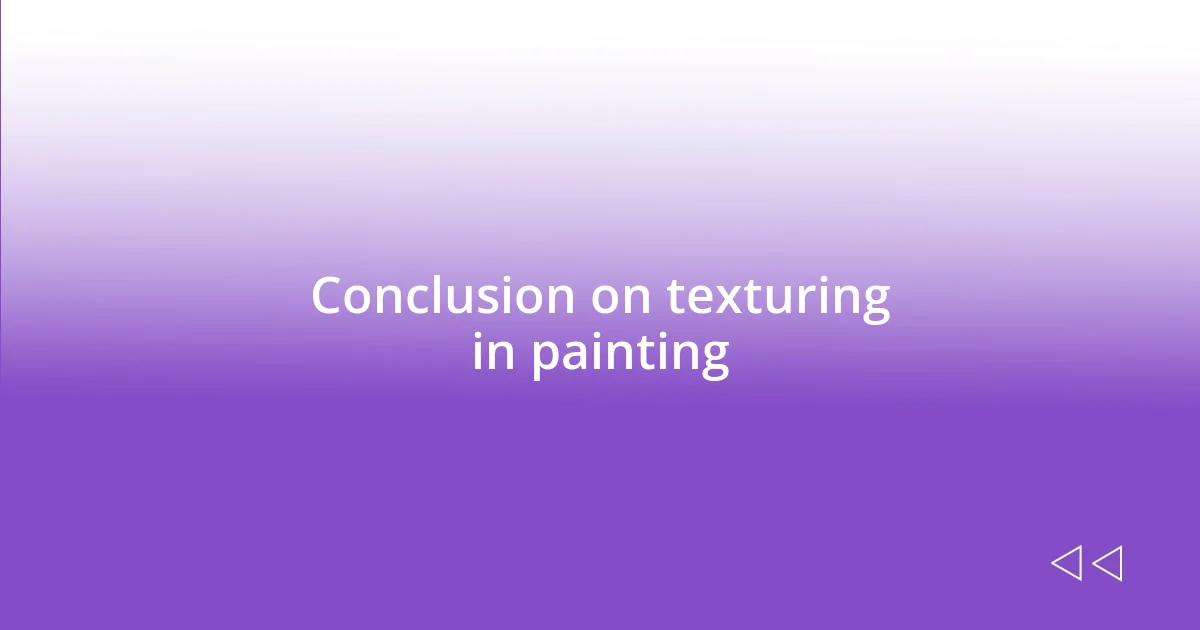
Conclusion on texturing in painting
When reflecting on texturing in painting, I realize that it is much more than a technique—it’s an invitation to express our inner creativity. I once felt overwhelmed by the idea of textures, thinking they would complicate my work. But as I dove deeper into techniques, I found that textures could evoke emotions and stories, making each artwork a unique journey. Have you ever had a piece transform before your eyes just because of a simple choice in texture?
The interplay of different surfaces can also bring out unexpected characteristics in your artwork. I vividly remember the first time I used a coarse canvas; the rough texture gave my paint a feeling of grit and depth that I had never experienced before. It was exhilarating to see how each application of paint adapted to its environment. Isn’t it fascinating that the surface can actually influence the emotion conveyed?
Ultimately, incorporating texturing allows for continuous growth and discovery as an artist. Each brush stroke, swipe, or dab adds another layer to our understanding—both of the medium and ourselves. Sometimes, I find myself lost in the process, feeling a profound connection with the work. Have you ever felt that sense of unity with your canvas, where the texture becomes an extension of your own voice?
